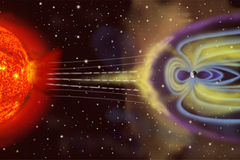HSE scientists have developed a model of the behavior of charged particles of lunar dust
Russian HSE scientists have developed a mathematical model explaining the levitation and movement of charged dust particles over the sunlit lunar surface. One of the key factors is the tail of the Earth's magnetosphere, which stretches from the night side of the planet. This is reported in an article published in the journal Physics of Plasmas.
It is known that the Moon is surrounded by plasma containing dust particles. Under the action of photons, electrons and ions of the solar wind, dust particles acquire a positive charge. Due to the interaction with the positively charged surface of the Moon, the particles begin to levitate, forming a dusty plasma.
The Earth's magnetosphere arises due to the interaction of the planet's magnetic field with charged particles from space. Solar wind particles deviate from their original trajectory and form an asymmetric region around the planet. A quarter of the Moon's orbit is located in the tail of the magnetosphere, which affects the movement of particles along the satellite's meridians, shifting them from the polar region to the equator. In addition, dust particles make vertical fluctuations over the surface of the Moon.
The effect of levitation is explained by the long days on the moon, which last about 15 Earth days. According to researchers, opposite phenomena are also observed in the Solar System. For example, on the Martian satellites, Phobos and Deimos, the decay time of the dust particles is longer than daylight, so they do not have time to go into a levitating state.

